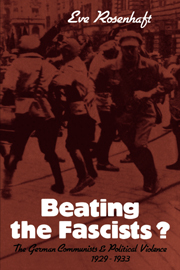Book contents
- Frontmatter
- Contents
- Preface
- List of abbreviations
- Map 1 Greater Berlin 1930
- Map 2 Central Berlin 1930
- 1 Introduction: Social crisis, radical politics and organized violence in Weimar Germany
- 2 The Party, the neighbourhood and the uses of violence in the ‘Third Period’
- 3 Defining the enemy: The wehrhafter Kampf against the SA in theory and propaganda
- 4 Organizing the wehrhafter Kampf: The Communist defence formations
- 5 Between ‘individual terror’ and ‘mass terror’: The campaign against the SA-taverns, 1931
- 6 The shape of violence in the neighbourhoods
- 7 Who were the streetfighters?
- 8 Conclusion: Communist politics in the Weimar Republic
- A note on sources
- Notes
- Bibliography
- Index
6 - The shape of violence in the neighbourhoods
Published online by Cambridge University Press: 05 March 2012
- Frontmatter
- Contents
- Preface
- List of abbreviations
- Map 1 Greater Berlin 1930
- Map 2 Central Berlin 1930
- 1 Introduction: Social crisis, radical politics and organized violence in Weimar Germany
- 2 The Party, the neighbourhood and the uses of violence in the ‘Third Period’
- 3 Defining the enemy: The wehrhafter Kampf against the SA in theory and propaganda
- 4 Organizing the wehrhafter Kampf: The Communist defence formations
- 5 Between ‘individual terror’ and ‘mass terror’: The campaign against the SA-taverns, 1931
- 6 The shape of violence in the neighbourhoods
- 7 Who were the streetfighters?
- 8 Conclusion: Communist politics in the Weimar Republic
- A note on sources
- Notes
- Bibliography
- Index
Summary
The case of Richardstrasse 35 and comparable incidents, seen as calculated risks embarked on by the middle-level Party bureaucracy, appear to confirm the official Communist view that ‘individual terror’ resulted from the isolation of the Communist organization from the community at large. Even these incidents, however, when considered from the perspective of the rank and file, take their place among the routine activities of the local defence organizations. Those, in turn, demand consideration as an integral part of the life of the neighbourhood. It hardly needs to be argued that each fighting group was subject not only to the broadly ideological and organizational pressures that constituted official policy but also to the influences of the neighbourhood situation in which it operated. These included, at one end of the scale, the simple fact of spiralling popular and police violence, to the demands of which, as has been pointed out, the Party leadership was relatively sensitive. At the other end of the scale lay all the forces working on the fighters as members of a community with its own concerns, attitudes, styles of action and interaction.
Among the Communists, the combination of the ‘social’ and the ‘political’ – and the character of the violence that depended on it – was a function of the street-politics of the Party. It was hardly within the power of the Party to wipe out the pre-political personalities of most of its members in any case, but the official attitude was itself ambivalent. The process by which the Communist organizations merged with the community provided the dynamic for KPD tactics in the ‘Third Period’.
- Type
- Chapter
- Information
- Beating the Fascists?The German Communists and Political Violence 1929–1933, pp. 128 - 166Publisher: Cambridge University PressPrint publication year: 1983
- 1
- Cited by



